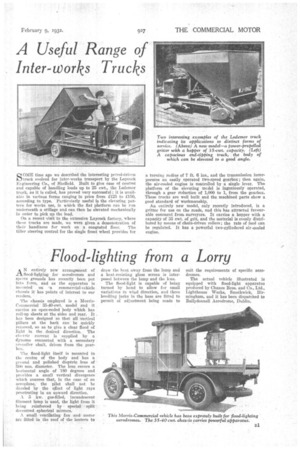Flood-lighting from a Lorry
Page 35

If you've noticed an error in this article please click here to report it so we can fix it.
AN entirely new arrangement of tlood-lighting for aerodromes and sports grounds has recently been put into force, and as the apparatus is
in e ii nted on a commercial-vehicle chassis it. has points of interest to our readers.
The chassis employed is a MorrisCommercial 35740-cwt. model and it carries an open-ended body which has roll-up sheets at the sides and rear. It has been designed so that all vertical pillars at the back can• be quickly removed, so as to give a clear flood of light in the desired direction. The eleetric current is supplied by a dynamo connected with a secondary propeller. shaft, driven from the gearbox.
The flood-light itself is mounted in the centre of the body and has a ground and polished diontric lens of 500 mm. diameter. The lens covers a horizontal angle of 180 degrees and provides a small vertical divergence which ensures that, in the case of an aeroplane,the pilot shall not be dazAed by the effect of light rayS penetrating in an upward direction.
A 5 kw. gas-filled, incandescent filamentlamp is used, the light from it being reinforced byspecial: split. deeentred •spherical mirrors.
A small ventilating fan and motor are fitted -in the roof -of the lantern to draw the heat away from the lamp and a heat-resisting glass screen is interposed between the lamp and the lens.
The flood-light is capable of being turned by hand to allow for small variations in wind direction, and three levelling jacks in the base are fitted to permit of adjustment being made to suit the requirements of specific aerodromes.
The actual vehicle illustrated is equipped with flood-light apparatus produced by Chance Bros. and Co., Ltd., Lighthouse Works, Smethwick, Birmingham, and it has been dispatched to Ballydlonnell Aerodrome, Dublin.




























































































